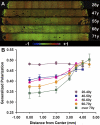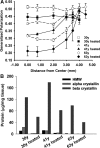α- and β-crystallins modulate the head group order of human lens membranes during aging
- PMID: 20484582
- PMCID: PMC3066618
- DOI: 10.1167/iovs.09-4947
α- and β-crystallins modulate the head group order of human lens membranes during aging
Abstract
Purpose: To examine the physical properties of human lens cell membranes as a function of age.
Methods: The environment of the phospholipid head groups in fiber cell membranes from human lenses, aged 22 to 83 years, was assessed with Laurdan and two-photon confocal microscopy. The effect of mild thermal stress on head group order was studied with lens pairs in which one intact lens was incubated at 50 °C. Dihydrosphingomyelin vesicles were preloaded with Laurdan, α-, β-, or γ-crystallin was added, and surface fluidity was determined.
Results: The membrane head group environment became more fluid with age as indicated by increased water penetration. Furthermore, these changes could be replicated simply by exposing intact human lenses to mild thermal stress; conditions which decreased the concentration of soluble α- and β-crystallins. Vesicle binding experiments showed that α- and β-, but not γ-, crystallins markedly affected head group order.
Conclusions: The physical properties of cell membranes in the lens nucleus change substantially with age, and α- and β-crystallins may modulate this effect. β-Crystallins may therefore play a role in lens cells, and cells of other tissues, apart from being simple structural proteins. Age-dependent loss of these crystallins may affect membrane integrity and contribute to the dysfunction of lenses in older people.
Figures





Similar articles
-
Large-scale binding of α-crystallin to cell membranes of aged normal human lenses: a phenomenon that can be induced by mild thermal stress.Invest Ophthalmol Vis Sci. 2010 Oct;51(10):5145-52. doi: 10.1167/iovs.10-5261. Epub 2010 Apr 30. Invest Ophthalmol Vis Sci. 2010. PMID: 20435594 Free PMC article.
-
Expression and regulation of alpha-, beta-, and gamma-crystallins in mammalian lens epithelial cells.Invest Ophthalmol Vis Sci. 2004 Oct;45(10):3608-19. doi: 10.1167/iovs.04-0423. Invest Ophthalmol Vis Sci. 2004. PMID: 15452068
-
Lens growth and protein changes in the eastern grey kangaroo.Mol Vis. 2011;17:3234-42. Epub 2011 Dec 14. Mol Vis. 2011. PMID: 22194649 Free PMC article.
-
Lipids and the ocular lens.J Lipid Res. 2010 Sep;51(9):2473-88. doi: 10.1194/jlr.R004119. Epub 2010 Apr 20. J Lipid Res. 2010. PMID: 20407021 Free PMC article. Review.
-
Ca2+ and βγ-crystallins: An affair that did not last?Biochim Biophys Acta. 2016 Jan;1860(1 Pt B):299-303. doi: 10.1016/j.bbagen.2015.06.012. Epub 2015 Jul 2. Biochim Biophys Acta. 2016. PMID: 26145580 Review.
Cited by
-
Cholesterol and cholesterol bilayer domains inhibit binding of alpha-crystallin to the membranes made of the major phospholipids of eye lens fiber cell plasma membranes.Exp Eye Res. 2021 May;206:108544. doi: 10.1016/j.exer.2021.108544. Epub 2021 Mar 17. Exp Eye Res. 2021. PMID: 33744256 Free PMC article.
-
Degradation of an old human protein: age-dependent cleavage of γS-crystallin generates a peptide that binds to cell membranes.J Biol Chem. 2012 Nov 9;287(46):39012-20. doi: 10.1074/jbc.M112.391565. Epub 2012 Sep 20. J Biol Chem. 2012. PMID: 22995907 Free PMC article.
-
Effect of Mild Heating on Human Lens Epithelial Cells: A Possible Model of Lens Aging.Sci Rep. 2016 Oct 11;6:33917. doi: 10.1038/srep33917. Sci Rep. 2016. PMID: 27725687 Free PMC article.
-
Interaction of βL- and γ-Crystallin with Phospholipid Membrane Using Atomic Force Microscopy.Int J Mol Sci. 2023 Oct 29;24(21):15720. doi: 10.3390/ijms242115720. Int J Mol Sci. 2023. PMID: 37958704 Free PMC article.
-
Instability of the cellular lipidome with age.Age (Dordr). 2012 Aug;34(4):935-47. doi: 10.1007/s11357-011-9293-6. Epub 2011 Sep 6. Age (Dordr). 2012. PMID: 21894448 Free PMC article.
References
Publication types
MeSH terms
Substances
Grants and funding
LinkOut - more resources
Full Text Sources
Medical

